
Dr. Sangeeta Sonak speaks on her achievements and projects as an environment researcher
Executive Director at the Centre for Environment and Natural Resource Management, Dr Sangeeta M Sonak, is a woman of substance, with numerous areas of expertise. With a Fulbright Fellowship and an Erasmus Mundus professorship under her belt, Dr Sonak’s lists of qualifications are infinitely stunning.
A marine biologist, Dr. Sangeeta has several years of research experience; of guiding research teams and co-ordinating research projects from various reputed international and national organisations such as the European Commission (EC), Asia Pacific Network (APN), Council of Scientific and Industrial Research (CSIR), International Development Research Centre (IDRC), Department for International Development (DFID).
Dr. Sangeeta credits the success of multiple projects to the co-operation that she receives from her team.
Her academic career has surpassed the barriers of gender, age, and nationality. Dr Sangeeta received an invitation fellowship for senior scientists awarded by the Japan Society for the Promotion of Science (JSPS) in April 2006 to deliver lectures and conduct research at the Graduate School of Global Environmental Studies, Kyoto University. She also headed TERI’s Western Regional Centre for a few years and has research experience at the National Institute of Oceanography.
The Goa Vidnyan Parishad awarded Dr. Sangeeta the ‘Shakti Prerana Puraskar’ in March 2014 for her dedication towards innovative research in environmental science.
Dr. Sangeeta has had the honour of conducting research and lectures at reputed universities such as Plymouth (UK), Kyoto (Japan) and the Virginia Tech Institute (Virginia, USA). When Dr Sangeeta was assigned a European Commission project on aquaculture in TERI, she chose to work on traditional aquaculture activities in khazans. Her book on khazans, commissioned by Springer International and published in 2014, is the only book on khazans in existence. She continues to work on the topic and would like to publish more books. Speaking of her interest in an unexplored domain such as khazan lands, as a child, Sangeeta was intrigued by words like khazan, agor (traditional fish farm or pond), and mithagor (salt pan). She always had a penchant for studying local traditions, culture, and bio-diversity. One of her goals was and is to research and document the unstudied local Goan ecosystems.
In the late 1990s, while working for The Energy and Resources Institute (TERI), the then Tata Energy Research Institute, she came across information from a report by Dr. Nandkumar Kamat. This sparked her interest in working on khazans. Some years later, she received more advanced international projects to continue her research on khazans.
Dr. Sangeeta explained that khazans, are low-lying reclaimed coastal wetlands, salt marshes, and mangrove areas, where tidal influence is regulated by the construction of bunds (embankments) and sluice gates. Their indigenous technology and architecture protects agricultural fields and villages from tidal ingress through a system of bunds (dykes), sluice gates, and poiem. The outer embankments or bunds are protective and are mostly built using locally available laterite stones, mud, and clay (called tharcupto) from the khazan farms. The inner embankments (mero) are made of mud and straw. These embankments prevent soil erosion.
When asked about the current legislation regarding khazan lands, Dr Sangeeta pointed out that while the CRZ Notification of 2011 made a particular provision for khazans, it was absent in the 2021 notification. Lack of public awareness and knowledge of khazan ecosystem services is a significant barrier to successful management of khazans. This is compounded by a lack of political will toward conserving this valuable ecosystem and citizen awareness will help in informed decision-making.
Dr. Sangeeta highlighted that tourism is an industry which should be utilised for positive environmental contributions. Efforts should be made to get the GI (Geographical Indicator) tag for salt-resistant khazan rice varieties such as Corgut rice. These provide us with food security, which will be particularly important in sea level rise and salinisation of coastal agricultural land.
In 2011, when Dr. Sangeeta was invited by Nobel Laureate Late Prof. Elinor Ostrom to present her paper on khazan ecosystems at Indiana University (USA) in an international workshop, many participants opined that these deserve to be included in the Globally Important Agricultural Heritage Systems (GIAHS) list, which features the saffron heritage of Kashmir and Kuttanad farms of Kerala.
Dr. Sangeeta elucidates that the loss of biodiversity is a grave concern. She observes that about 39 areas in the Western Ghats are identified and listed as UNESCO World heritage sites, but not a single site is located in Goa. Most of the causes of environmental degradation in Goa are anthropogenic.
Having worked on a project on St. Inez Creek with GSPCB, she emphasised that pollution, solid waste management and depletion of fresh water need to be addressed. She recommends rainwater harvesting as an efficient alternative to the Mhadei Dam in Karnataka, to provide us with sufficient water.
Dissemination has always been a major feature in Dr. Sangeeta’s research projects. She believes that apart from research papers and academic reports, scientists should reach out to people, and attempt to explain science in fluid, non-technical language while arousing the reader’s interest. An author of five books, Dr. Sangeeta has also written popular science and science fiction stories in Konkani. She aspires to write children’s books on science. In her research paper from the Journal of Environmental Management (Feb 2009), she has aptly quoted Enrique Jardiel Poncela: ‘when something can be read without effort, great effort has gone into its writing.’





